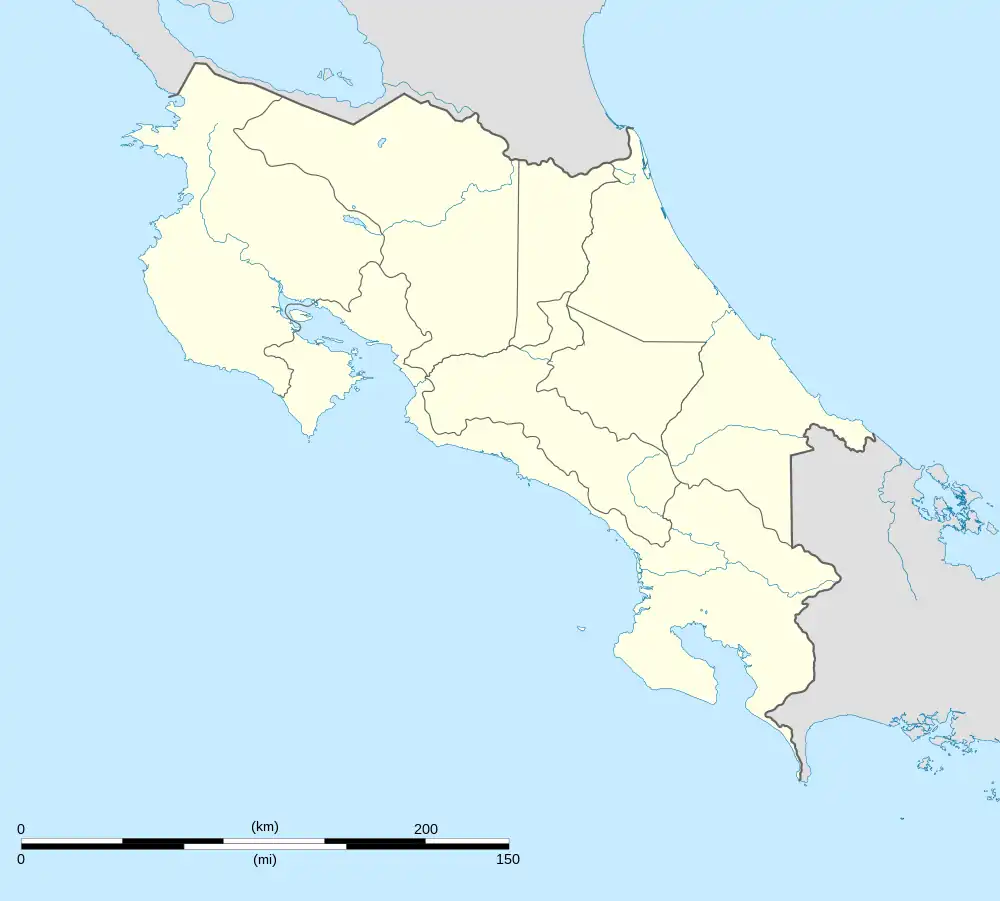Pococí (canton)
Pococí is a canton in the Limón province of Costa Rica.[2][3] The head city is in Guápiles district, which houses many of the canton's services and businesses.
Pococí | |
|---|---|
 Flag  Seal | |
Pococí canton | |
 Pococí Pococí canton location in Costa Rica | |
| Coordinates: 10.5008914°N 83.6446083°W | |
| Country | |
| Province | Limón |
| Creation | 19 September 1911[1] |
| Head city | Guápiles |
| Districts | |
| Government | |
| • Type | Municipality |
| • Body | Municipalidad de Pococí |
| Area | |
| • Total | 2,403.49 km2 (927.99 sq mi) |
| Elevation | 134 m (440 ft) |
| Population (2011) | |
| • Total | 125,962 |
| • Density | 52/km2 (140/sq mi) |
| Time zone | UTC−06:00 |
| Canton code | 702 |
| Website | munipococi |
History
Pococí was created on 19 September 1911 by decree 12.[1]
Geography
Pococí has an area of 2,403.49 km2[4] and a mean elevation of 134 metres.[2]
The canton takes in the Caribbean coast from the Toro River northward to the border with Nicaragua. It ranges inland in a southwestern direction with the Chirripó River forming the western border. The canton ends in the Cordillera Central where the Sucio River crosses the National Route 32 in Braulio Carrillo National Park.
Districts
The canton of Pococí is subdivided into the following districts:
Demographics
| Historical population | |||
|---|---|---|---|
| Census | Pop. | %± | |
| 1927 | 2,974 | — | |
| 1950 | 10,482 | 252.5% | |
| 1963 | 16,927 | 61.5% | |
| 1973 | 28,688 | 69.5% | |
| 1984 | 44,187 | 54.0% | |
| 2000 | 103,121 | 133.4% | |
| 2011 | 125,962 | 22.1% | |
|
Instituto Nacional de Estadística y Censos[5] |
|||
For the 2011 census, Pococí had a population of 125,962 inhabitants.[7]
Transportation
Road transportation
The canton is covered by the following road routes:
Tourism
The Caribbean coast of Pococí boasts extensive wetlands and several protected areas, including Tortuguero National Park and Barra del Colorado Wildlife Refuge. In the Braulio Carrillo area is located the first aerial tram in the world to travel through a rainforest, called Rainforest Adventures and recently added to NatGeographic's top ten adventure trips.[8] Much of the northern portion of the canton is inundated year-round or seasonally, and inaccessible by road. The wetlands stretch inland the length of the canton. The coastal areas provide important sea turtle nesting habitat. These protected areas and wetlands are an important eco-tourism destination.
References
- Hernández, Hermógenes (1985). Costa Rica: evolución territorial y principales censos de población 1502 - 1984 (in Spanish) (1 ed.). San José: Editorial Universidad Estatal a Distancia. pp. 164–173. ISBN 9977-64-243-5. Retrieved 5 October 2020.
- "Declara oficial para efectos administrativos, la aprobación de la División Territorial Administrativa de la República N°41548-MGP". Sistema Costarricense de Información Jurídica (in Spanish). 19 March 2019. Retrieved 26 September 2020.
- División Territorial Administrativa de la República de Costa Rica (PDF) (in Spanish). Editorial Digital de la Imprenta Nacional. 8 March 2017. ISBN 978-9977-58-477-5.
- "Área en kilómetros cuadrados, según provincia, cantón y distrito administrativo". Instituto Nacional de Estadística y Censos (in Spanish). Retrieved 26 September 2020.
- "Instituto Nacional de Estadística y Censos" (in Spanish).
- "Sistema de Consulta de a Bases de Datos Estadísticas". Centro Centroamericano de Población (in Spanish).
- "Censo. 2011. Población total por zona y sexo, según provincia, cantón y distrito". Instituto Nacional de Estadística y Censos (in Spanish). Retrieved 26 September 2020.
- "Photos: Top 10 Adventure Trips -- National Geographic". 8 December 2014.